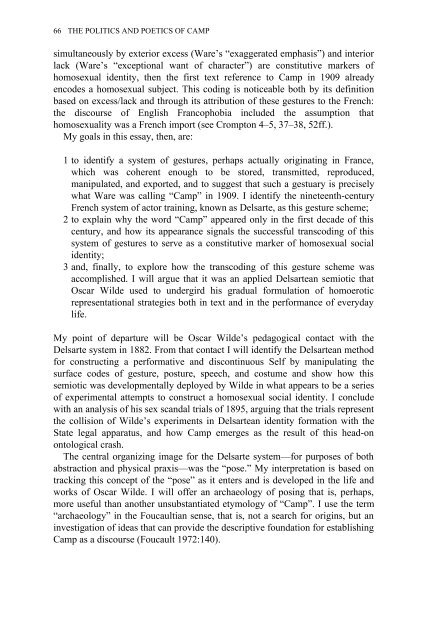Edited by Moe Meyer - Get a Free Blog
Edited by Moe Meyer - Get a Free Blog
Edited by Moe Meyer - Get a Free Blog
Create successful ePaper yourself
Turn your PDF publications into a flip-book with our unique Google optimized e-Paper software.
66 THE POLITICS AND POETICS OF CAMP<br />
simultaneously <strong>by</strong> exterior excess (Ware’s “exaggerated emphasis”) and interior<br />
lack (Ware’s “exceptional want of character”) are constitutive markers of<br />
homosexual identity, then the first text reference to Camp in 1909 already<br />
encodes a homosexual subject. This coding is noticeable both <strong>by</strong> its definition<br />
based on excess/lack and through its attribution of these gestures to the French:<br />
the discourse of English Francophobia included the assumption that<br />
homosexuality was a French import (see Crompton 4–5, 37–38, 52ff.).<br />
My goals in this essay, then, are:<br />
1 to identify a system of gestures, perhaps actually originating in France,<br />
which was coherent enough to be stored, transmitted, reproduced,<br />
manipulated, and exported, and to suggest that such a gestuary is precisely<br />
what Ware was calling “Camp” in 1909. I identify the nineteenth-century<br />
French system of actor training, known as Delsarte, as this gesture scheme;<br />
2 to explain why the word “Camp” appeared only in the first decade of this<br />
century, and how its appearance signals the successful transcoding of this<br />
system of gestures to serve as a constitutive marker of homosexual social<br />
identity;<br />
3 and, finally, to explore how the transcoding of this gesture scheme was<br />
accomplished. I will argue that it was an applied Delsartean semiotic that<br />
Oscar Wilde used to undergird his gradual formulation of homoerotic<br />
representational strategies both in text and in the performance of everyday<br />
life.<br />
My point of departure will be Oscar Wilde’s pedagogical contact with the<br />
Delsarte system in 1882. From that contact I will identify the Delsartean method<br />
for constructing a performative and discontinuous Self <strong>by</strong> manipulating the<br />
surface codes of gesture, posture, speech, and costume and show how this<br />
semiotic was developmentally deployed <strong>by</strong> Wilde in what appears to be a series<br />
of experimental attempts to construct a homosexual social identity. I conclude<br />
with an analysis of his sex scandal trials of 1895, arguing that the trials represent<br />
the collision of Wilde’s experiments in Delsartean identity formation with the<br />
State legal apparatus, and how Camp emerges as the result of this head-on<br />
ontological crash.<br />
The central organizing image for the Delsarte system—for purposes of both<br />
abstraction and physical praxis—was the “pose.” My interpretation is based on<br />
tracking this concept of the “pose” as it enters and is developed in the life and<br />
works of Oscar Wilde. I will offer an archaeology of posing that is, perhaps,<br />
more useful than another unsubstantiated etymology of “Camp”. I use the term<br />
“archaeology” in the Foucaultian sense, that is, not a search for origins, but an<br />
investigation of ideas that can provide the descriptive foundation for establishing<br />
Camp as a discourse (Foucault 1972:140).


